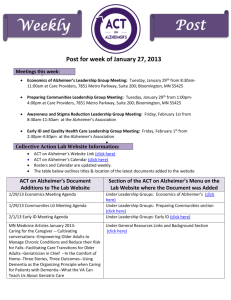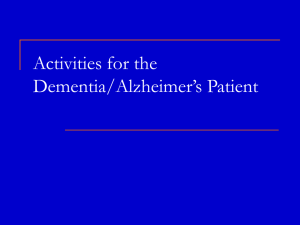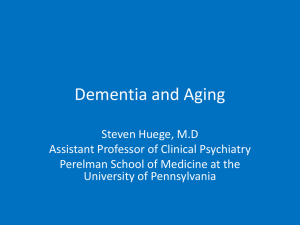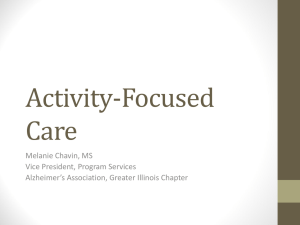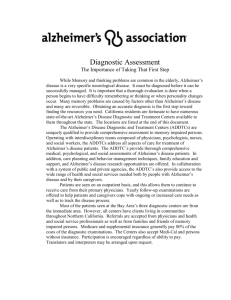Environmental Influences on People with Dementia
advertisement
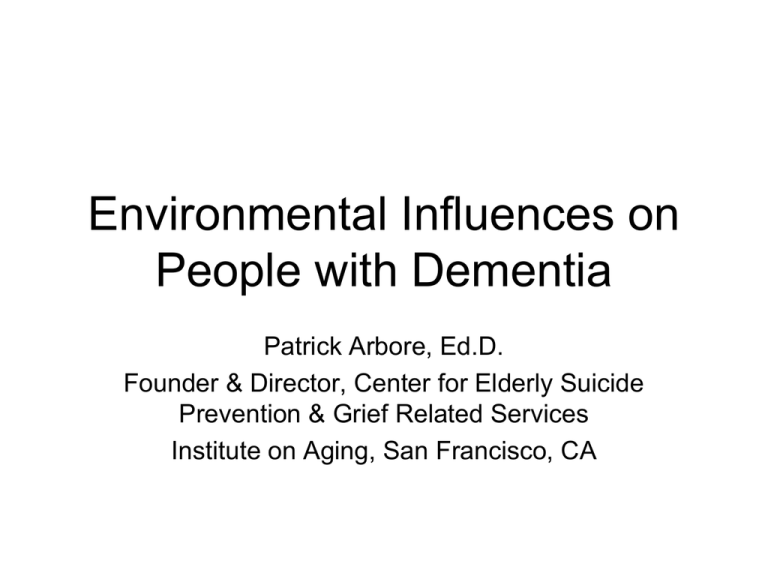
Environmental Influences on People with Dementia Patrick Arbore, Ed.D. Founder & Director, Center for Elderly Suicide Prevention & Grief Related Services Institute on Aging, San Francisco, CA Center for Elderly Suicide Prevention & Grief Related Services (CESP) 24-hour Friendship Line for the Elderly – 800-971-0016 Individual Grief Counseling and Traumatic Loss Groups Medication Oversight Project Contact: parbore@ioaging.org or (415) 7504180x230 National Alzheimer’s Association • This year (2011), the first baby boomers turn 65 • While AD is not normal aging, age is the greatest risk factor for the disease • AD is a progressive and fatal brain disorder that causes problems with memory, thinking and behavior • AD kills but not before it takes everything away from the person National Alzheimer’s Association • An estimated 10 million baby boomers will develop AD • Of those who reach the age of 85, nearly one in two will develop AD • Unless there is a treatment or cure, AD will become the defining disease of the Baby Boom generation • Today 5.3 million Americans have AD AD • Try to imagine not being able to take care of yourself – Can’t dress yourself, can’t shower yourself, can’t go to the bathroom by yourself – That’s Alzheimer’s Disease Overview of the Environment What does the environment tell us – • The general style, layout and atmosphere tells us what we can expect, how we should behave, whether or not we belong there, and whether we will get what we need there • If the setting appears institutional, it tells us that there are important people in charge Overview • We go to institutions to do business or to have things done to us • Many cognitively impaired older people assume a passive role in institutional settings • They may worry about how meals are paid for or when they are supposed to leave • A home environment is more suitable Overview The physical environment can do much to alleviate difficult behavior: • Ensuring security, emotional as well as physical • Accurately reflecting the individual’s identity and promoting self esteem • Offering opportunities for meaningful occupation and independence Negative Environments • Some physical environments can contribute to altercations or hostile behavior • Dead-end corridors, especially ending in locked doors, can create traffic problems that can raise anxiety levels • Restless residents are attracted by the door, go towards it, and are frustrated to find it locked Negative Environments • When the person becomes agitated and sees other people coming towards him, he/she may bump someone or push someone and scuffles break out • Narrow doorways create similar problems of shoving and pushing Privacy • Privacy is a powerful need that is often difficult to accommodate • Private rooms are usually taken by people who can afford them • Residences that accommodate persons with AD are making rooms available according to need • Shared accommodations are sometimes desirable Privacy • If roommate situations are available, it is advisable to prevent one person from passing through the space of the other • Bookshelves and room dividers can avoid antagonism and prevent disputes Co-existing Disabilities • The cognitively impaired person is less able to cope with other disabilities that may limit his/her autonomy Features that Spark Memories • Look carefully at the environment and check whether alternative perceptions might occur • Bars on windows or doors might trigger thoughts of bank tellers – the person may ask for money from his/her account only to be frustrated when staff indicate that they have no money here – to them it looks like a bank teller window The Environment and Identity • Most people want their environment to reflect their being in the manner they prefer • People do not want to appear childish or incompetent • Orientation boards that announce the day, weather, next meal etc. states that the people here do not know what is happening Environment and Identity • It might be better for a cognitively impaired person to have windows where they could look out and see the weather • It might be better to have large calendars with month and date easily visible • A large clock that indicates time of day • The smells from the kitchen can announce that a meal is being prepared Environment and Culture • Everyone thrives in an environment that accommodates the individual skills, needs, and limitations of all its members • People benefit where information, responsibility, and influence are openly shared • People benefit where failure of a person to meet a norm is not a fault Environment and Culture • People benefit where every individual is openly recognized as being equally important and worthy of respect Mayo Clinic on Alzheimer’s Disease Environment – • Can have a definite impact on the person with AD’s behavior • A noisy room may seen overwhelming • Groups of visitors may trigger agitation • When outside, it may be easier to avoid large, loud settings • Familiar destinations may be easiest Mayo Clinic • Avoid doing too many activities on a single trip • Plan rest periods between activities • Environments can be confusing – A long hallway may be baffling to someone; mirrors might be disturbing; give cues to help the person navigate the space (use arrows taped to the wall or floor) Mayo Clinic • Put a picture of a toilet on the door to a bathroom • Put a picture of their younger selves on the door to the bedroom • The most important aspect of the environment is how it feels The Physical Environment The setting must address more than the basic requirements of space, esthetic appeal, lighting, air circulation, cleanliness, and accessibility • The area should be free of ambiguities • It should be consistent and predictable • Floor and wall areas should be distinct from one another The Physical Environment • Steps and other obstacles must be clearly visible • The floor should be free of any markings that could be perceived as obstacles by the perceptually impaired older person • Furniture should have clear limits • Furniture should be distinct from its surroundings The Physical Environment • Traffic areas must be free of any hidden obstacles such as chair legs that extend out beyond the seat • Contrasting colors can be used effectively to distinguish furniture from the surrounding area • Color can be used to reinforce visual perspective in the room The Physical Environment • If the floor and walls blend into one another, distances become very difficult to judge accurately • Bathrooms should be visible Sensory Stimuli • Environment must not be overly stimulating • General ambiance should be subdued and neutral • Background noise and movement should be minimized • Soundproof barriers between activity areas are useful – providing they don’t complicate the space Place and Time • There should be appropriate cues to help people orient themselves to place and time • Clocks (analog), large calendars, signs, articles or decorations in keeping with the seasons or holidays • There should be a space for those individuals who need to be alone from time to time Maintaining a Safe Environment As the person with dementia progresses with the illness, the ability to perform every day functions decreases • Standing to dress may become unsafe • Falls and complications from falls is a major concern • Caregivers must look for actual and/or potential safety problems A Safe Environment Safety actions may look like: • Removing unsafe objects or personal care items • Rearranging furniture • Disconnecting cooking elements or microwave ovens • Retraining the person to perform activities differently Maintaining Body Warmth • The person with dementia may not be able to verbalize being too cold or too hot • A person who does not want to take their coat off may be indicating a need for a warmer room temperature • The older person is more comfortable with temperatures in the middle to upper 70’s Body Warmth • The person with dementia may be sensitive to hot or cold water • Be careful about water heaters that may be too hot for that person • Luke-warm water may be preferred for drinking or oral hygiene Making Decisions About Driving Signs of Unsafe Driving: • Has difficulty following instructions and directions • Coasts to a near stop in the midst of moving traffic • Drifts into other lanes of traffic • Stops abruptly without cause • Presses simultaneously on the brake and accelerator or confuses the two pedals Driving • Delays changing lanes when obstacles appear • Does not signal when turning or changing lanes • Has received an increasing number of driving citations or warnings • Does not check “blind spot” before changing lanes Driving • • • • Gets lost in familiar places Is increasingly nervous when driving Backs up after missing an exit Falls asleep or gets drowsy while driving When these and other signs appear, it is time to assess the situation – Don’t wait for an accident Thomas DeBaggio “With my failing memory every day begins new—and often ends that way, unable to negotiate a past as short as twelve hours.” References Alzheimer’s Association (2011). Generation Alzheimer’s: The defining disease of the baby boomers Bridges, B. (1998). Therapeutic caregiving: A practical guide for caregivers of persons with Alzheimer’s and other dementia causing diseases. Mill Creek, WA: BJB Publishing References Petersen, R. (ed) (2002). Mayo clinic on Alzheimer’s Disease. Rochester, MN: Mayo Clinic. Schmall, V., Cleland, M., and Sturdevant, M. (2000). The caregiver helpbook: Powerful tools for caregiving. Portland: Legacy Caregiver Services. References Zgola, J. (1987). Doing things: A guide to programming activities for persons with Alzheimer’s Disease and related disorders. Baltimore: The Johns Hopkins University Press. Zgola, J. (1999). Care that works: A relationship approach to persons with dementia. Baltimore: The Johns Hopkins University Press.



